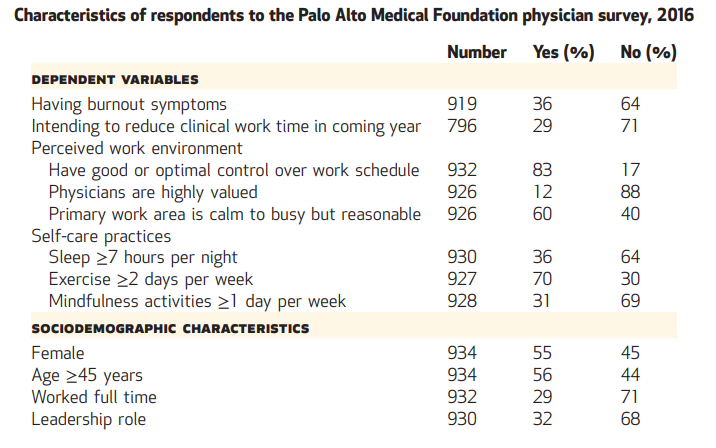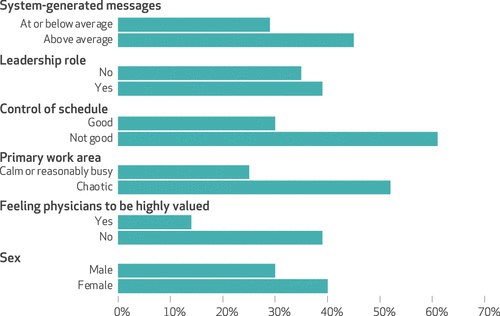Health Affairs
Ming Tai-Seale, Ellis C. Dillon, Yan Yang, Robert Nordgren, Ruth L. Steinberg, Teresa Nauenberg, Tim C. Lee, Amy Meehan, Jinnan Li, Albert Solomon Chan, and Dominick L. Frosch
JULY 2019
medstar
Key messages
by Joaquim Cardoso MSc
Digital Health and AI . Institute
March 30, 2022
- In-basket messages generated by the EHR system accounted for almost half of the weekly in-basket messages received per physician, on average — far exceeding the numbers received from their colleagues (53) and patients (30).
- Receiving more than the average number of system-generated in-basket messages was associated with 40 percent higher probability of burnout and 38 percent higher probability of intending to reduce clinical work time.
- Meaningful redesign of EHR in-basket workflow and a wellness-enhancing work environment are necessary to effectively improve
ORIGINAL PUBLICATION (excerpted version)

Physicians’ Well-Being Linked To In-Basket Messages Generated By Algorithms In Electronic Health Records
Health Affairs
Ming Tai-Seale, Ellis C. Dillon, Yan Yang, Robert Nordgren, Ruth L. Steinberg, Teresa Nauenberg, Tim C. Lee, Amy Meehan, Jinnan Li, Albert Solomon Chan, and Dominick L. Frosch
JULY 2019
Abstract
Despite concerns about physicians’ workload associated with electronic health records (EHRs), little attention has been paid to the relationship between physicians’ well-being and the in-basket messages physicians receive — specifically, their volume and sources.
Analyses of EHR work performed by physicians in a multispecialty practice found that in-basket messages generated by the EHR system accounted for almost half (114) of the 243 weekly in-basket messages received per physician, on average — far exceeding the numbers received from their colleagues (53) and patients (30).
Analyses of EHR work performed by physicians in a multispecialty practice found that in-basket messages generated by the EHR system accounted for almost half (114) of the 243 weekly in-basket messages received per physician, on average — far exceeding the numbers received from their colleagues (53) and patients (30).
In a survey, 36 percent of the physicians reported burnout symptoms, and 29 percent intended to reduce their clinical work time in the upcoming year.
Receiving more than the average number of system-generated in-basket messages was associated with 40 percent higher probability of burnout and 38 percent higher probability of intending to reduce clinical work time.
Receiving more than the average number of system-generated in-basket messages was associated with 40 percent higher probability of burnout and 38 percent higher probability of intending to reduce clinical work time.
Physicians’ perceptions of a positive work environment were associated with lower odds of burnout and intention to reduce clinical work time and with greater satisfaction with life.
Female physicians had a higher risk of burnout and lower satisfaction with life, compared to males.
Meaningful redesign of EHR in-basket workflow and a wellness-enhancing work environment are necessary to effectively improve physicians’ well-being.
Meaningful redesign of EHR in-basket workflow and a wellness-enhancing work environment are necessary to effectively improve physicians’ well-being.

Introduction
The electronic health record (EHR) potentially creates a 24/7 work environment for physicians. Its impact on physicians’ wellness has become a challenge for most health care delivery organizations. Understanding the relationships between physicians’ well-being and “desktop medicine”1 work in the EHR and work environment is critical if burnout is to be addressed more effectively.
While various causes of burnout have been examined in prior research, including workload, efficiency, meaning in work, culture and values, control and flexibility, social support and community at work, and work-life integration,2 only one previous effort has examined the role played by EHR workload.3 That study, which relied on physicians’ self-reported time using EHRs and computerized order entry, found that burnout was associated only with the latter.
A growing research literature suggests that time spent by physicians on the EHR has been linked to their reduced satisfaction with work.4–6 An analysis of EHR log data on the distribution of work time of 471 primary care physicians (in family medicine, internal medicine, or pediatrics) suggests that over 50 percent of their time is spent on desktop medicine tasks.1 A study of 142 family physicians reports that managing the EHR’s in-basket takes about 23 percent of their workday.7 Despite concerns about the amount of physicians’ time spent on EHR in-baskets,7,8 the literature is relatively silent regarding the sources of in-basket messages and their relative volumes. Given the correlation between physician workload and desktop medicine1 and the rising number of physicians who report burnout,9 it is important to carefully examine the relationship between pivotal aspects of desktop medicine and physicians’ well-being. As federal meaningful-use regulations continue to shape how health care organizations deliver care, the impact of desktop medicine workload on physicians’ well-being can have critical policy implications.10
Study Data And Methods
See the original publication
Study Results
See the original publication
Thirty-six percent of responding physicians reported burnout symptoms, and twenty-nine percent expressed an intention to reduce their clinical work time in the coming year (exhibit 1). The average score on life satisfaction was 78.22 out of 100 (see the exhibit 1 notes).
Exhibit 1 Characteristics of respondents to the Palo Alto Medical Foundation physician survey, 2016

SOURCE Authors’ analysis of data for 2016 from a survey of physicians at the Palo Alto Medical Foundation and the foundation’s electronic health records, 2016.
It is noteworthy that only 12 percent of respondents deemed the statement “physicians are highly valued” to be completely true regarding conditions in their primary practice setting (exhibit 1). Eighty-three percent reported having good or optimal control over their work schedule, and 60 percent reported having a calm to busy but reasonable primary work area.
The average number of weekly in-basket messages was 243, of which 114 (47 percent) were generated by the EHR system (exhibit 2). These included pending orders automatically sent to physicians according to algorithm-driven health maintenance reminders,19 requests for prior authorization, patient reminders, and many more. Only 30 messages per week were directly from patients. Fifty-three were from other physicians or care team members, and 31 were from the physicians themselves (for example, reports of laboratory tests they had ordered). Forty-two percent of physicians received above the average number of messages (114 per week) (data not shown).
Exhibit 2 Weekly average number of in-basket messages, by source and physician specialty, 2016

SOURCE Authors’ analysis of data for 2016 from the Palo Alto Medical Foundation’s administrative and electronic health records. NOTES “System” refers to the electronic health record system. “Team” refers to other physicians or care team members. E&M is evaluation and management.
System-generated messages stood out as the largest source of messages for all specialties, especially for internal medicine (209) and family medicine (204), followed by pediatricians (102) (exhibit 2). The second-largest source across all specialties was other physicians or care team members. For primary care physicians (those in internal medicine, family medicine, or pediatrics), the third-largest source of messages was patients; for specialists, the third-largest source of messages was themselves.
Exhibit 3 shows the relationship between burnout symptoms and system-generated in-basket message volume, having a leadership role, perceptions of having control over one’s work schedule, having a calm to busy but reasonable primary work area, feeling valued, and being female. Notably, 45 percent of physicians with burnout symptoms received greater-than-average numbers of weekly system-generated in-basket messages, whereas 29 percent of physicians with burnout symptoms received only average or less-than-average numbers of the messages.
Exhibit 3 Percent of physicians with burnout symptoms, by system-generated in-basket messages and selected other characteristics, 2016

SOURCE Authors’ analysis of data for 2016 from a survey of physicians at the Palo Alto Medical Foundation and the foundation’s electronic health records. NOTE “System” refers to the electronic health record system.
The regression results suggest that factors associated with higher odds of burnout include an above-average number of system-generated in-basket messages and being female (exhibit 4). Factors associated with lower odds of burnout include feeling that physicians are highly valued; having good control over one’s work schedule; and having a calm or busy but reasonable work environment. Those factors were also associated with lower odds of intending to reduce clinical work hours and having higher life satisfaction. In contrast, high system-generated in-basket message volume; family medicine, internal medicine, and nonsurgical procedural specialties (compared to pediatricians) were associated with higher odds of intending to reduce clinical work hours. Female physicians had lower life satisfaction than males did.
Exhibit 4 Factors associated with physicians’ having burnout symptoms, intending to reduce work hours, and life satisfaction, 2016

SOURCE Authors’ analysis of data for 2016 from a survey of physicians at the Palo Alto Medical Foundation and the foundation’s electronic health records.
To illustrate the association between burnout, intention to reduce clinical work hours, and the key explanatory variable — above-average volumes of system-generated in-basket messages — we calculated the variable’s marginal effects on burnout and intention to reduce clinical work hours. The results suggested that, at the margin, receiving an above-average number of system-generated messages was associated with a 40 percent increase in the probability of burnout and a 38 percent increase in the probability of intending to reduce clinical work hours (data not shown).
Discussion
Almost half of all weekly in-basket messages came from EHR algorithms, and they were significantly associated with physicians having burnout symptoms and intending to reduce their clinical work hours. These are new findings that deserve careful consideration. The finding that family physicians and internists receive disproportionately high numbers of system-generated messages (greater than 2.5 times the volume of surgeons, 4.0 times that of nonprocedural evaluation and management–oriented specialists, and 5.0 times that of nonsurgical proceduralists) also calls for our attention. Keeping up with system-generated messages can be overwhelming, particularly for internists and family physicians. Some of those messages are generated by population health management algorithms that remind physicians to perform work that might have otherwise been overlooked. These were in addition to messages coming directly from patients and from other physicians or care team members. Therefore, both perceived and realized loss of autonomy over their work schedules could leave physicians feeling defeated,20 even though some of these system-generated messages have been shown to improve certain processes of care for patients with chronic illnesses.19
Health care organizations need to reconsider some of their approaches to improving the quality of care and population health. Physicians might not be the most appropriate recipients of some system-generated messages. Payers and government regulators may need to be part of the solution in enabling physicians to practice at the top of their license. EHR design engineers also need to reconsider whether system-generated automatic messages are the best way to ensure quality of care. It may be time to examine whether every reminder to order routine chronic disease management lab tests (for example, periodic glycosylated hemoglobin A1c tests) must be signed and placed by a physician.
Health care organizations may benefit from engaging with their physicians in creating optimal policies on email work, in addition to helping them with such work. Limiting desktop medicine work during evenings, weekends, and holidays, unless the physician is on call, could reduce burnout. Health care organizations could allow messages to reach physicians’ in-baskets only during work hours, conveying the message that physicians are so highly valued that the organization wants to protect their private time. To reduce the number of messages reaching physicians’ in-baskets, some messages (such as prescription refill requests) may be delegated to nonphysician clinicians (for example, registered nurses or clinical pharmacists) on the care team.
Another finding also calls for attention. Compared to pediatricians, physicians in four specialties (surgeons were the only exception) had higher odds of intending to reduce clinical work hours in the coming year. Inaction or ineffective actions in addressing the mounting in-basket workload and issues with physicians’ work environment could exacerbate their burnout and result in more reduction in work hours,21 which could negatively affect patients’ access to care and organizations’ workforce stability.
Female physicians had 1.4 times higher odds of burnout and 3 points lower satisfaction with life, compared to male physicians. While these findings have been reported previously,22 actions are still needed to support female physicians. It is necessary to recognize the different manifestations of burnout symptoms across physician genders. Female physicians have been documented to first suffer from emotional exhaustion, whereas male physicians first experience depersonalization.22 Female physicians are also more likely to experience burnout resulting from work-home conflict, whereas workload was a key predictor of burnout for male physicians.23 More flexibility in work schedules may enable female physicians to better harmonize work-home responsibilities and achieve joy in work and home life.24
The EHR has become the symbol of physician burnout.25 The reality of physician wellness is complex, however. Physicians feel that they are being consumed not only by cumbersome EHR work but also by fee-for-service payment — among other detractors to their wellness.24 Burnout risk factors that are modifiable by organizational changes include the workplace environment, physicians’ perception of being valued, and control over their work schedules. Organizational leaders can address these factors through changes in their communication with physicians, staffing, and scheduling. Policy makers and organizations also need to effectively address desktop medicine work, including redesigning in-basket work responsibilities. Using computer algorithms to send messages to physicians may need to be balanced with considerations of what brings joy and which tasks are truly physicians’ work. As noted in the “Study Data And Methods” section above, we did not observe that the amount of time physicians spent in EHR progress notes was significantly associated with burnout (results not shown). When we discussed the absence of a significant relationship between burnout and progress notes work with physicians, we learned that they considered work in progress notes to be work that they perform with more autonomy. They derived professional satisfaction from writing good notes.
Only a small proportion of in-basket messages came from patients and other clinicians, whereas almost half were generated by system algorithms. Receiving an above-average number of system-generated messages was associated with 40 percent higher probability of physicians having burnout symptoms and 38 percent higher probability of intending to reduce their clinical work hours. Collective actions are needed at the national and local organizational levels to bring about systematic changes to this previously little-known yet important source of friction.
References and additional information
See the original publication
Originally published at https://www.healthaffairs.org
About the authors & affiliations
Ming Tai-Seale, Ellis C. Dillon, Yan Yang, Robert Nordgren, Ruth L. Steinberg, Teresa Nauenberg, Tim C. Lee, Amy Meehan, Jinnan Li, Albert Solomon Chan, and Dominick L. Frosch
Ming Tai-Seale is a professor in the Department of Family Medicine and Public Health,
University of California San Diego; director of outcomes analysis and scholarship at UC San Diego Health; and director of research at UCSD Health Sciences International, in La Jolla.
Ellis C. Dillon is an assistant scientist in the Research Institute,
Palo Alto Medical Foundation, in California.
Yan Yang is a research economist in the Research Institute,
Palo Alto Medical Foundation.
Robert Nordgren is CEO of the
Palo Alto Foundation Medical Group.
Ruth L. Steinberg is chair of the Physician Wellbeing Committee,
Palo Alto Medical Foundation.
Teresa Nauenberg is a physician in the internal medicine and concierge medicine departments at the
Palo Alto Medical Foundation.
Tim C. Lee is a physician in the pediatrics department, Palo Alto Medical Foundation.
Amy Meehan is a research associate in the Research Institute,
Palo Alto Medical Foundation.
Jinnan Li is a quantitative analyst in the Research Institute,
alo Alto Medical Foundation.
Albert Solomon Chan is chief of digital patient experience and an investigator at Sutter Health, in Palo Alto, and an adjunct professor at the Stanford Center for Biomedical Informatics Research,
Stanford School of Medicine, in California.
Dominick L. Frosch is director of the Research Institute,
Palo Alto Medical Foundation.












